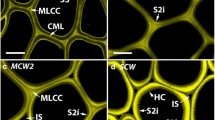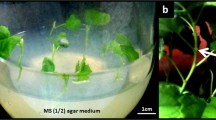Abstract
The nature of the wall layers observed in suberized tyloses was studied in Populus basalmifera L., Ulmus americana L. and Quercus rubra L. As the suberin layers were present only in tyloses that had completed their expansion, most of the results concern mature tyloses. The cyto- and immunocytochemical tests were conducted, respectively, with an exoglucanase having a binding affinity for β(1→4)-D-glucans, the subunits of cellulose, and with two monoclonal antibodies specific for un-esterified and esterified pectic molecules. In the three species, labelling for pectic compounds was intense over the external layer of tyloses but usually more dispersed or nearly absent over the layer corresponding to a primary wall that was, however, intensely labelled for β(1→4)-D-glucans. The outer wall layer, comparable to a middle lamella in mature tyloses, was continuous with similar material that appeared to be secreted by the tylosis. This material was particularly abundant in pit chambers, in void spaces between the tylosis and the vessel wall, particularly at the junction of the vessel and two adjacent cells, and close to the rim of vessel perforation plates. In P. balsamifera, a single suberized layer or occasionally a succession of suberized and cellulose-containing layers was observed internal to the tylosis primary wall. In U. americana, the wall of tylosis was similar to that of P. balsamifera except that, at times, a secondary-wall-like layer was formed and only a single suberized layer was observed. In Q. rubra, the suberized layer was always observed internal to the tylosis secondary wall. Simple pits were also constantly noted in Q. rubra tyloses. The occasional occurrence of a cellulosic layer internally to the suberized layer was observed in the three species. Histochemical tests revealed that lignin was also an important component of the tylosis wall. The tyloses frequently contained phenolic compounds in close association with the suberized layers. The significance of the formation of suberized tyloses in trees is discussed.
Similar content being viewed by others
Abbreviations
- TEM:
-
transmission electron microscope
References
Alberts, B., Bray, D., Lewis, J., Raff, M., Roberts, K., Watson, J.D., eds. (1989) Molecular biology of the cell. Garland Publishing Inc., New York London
Bacic, A., Harris, P.J., Stone, B.A. (1988) Structure and function of plant cell walls. In: The biochemistry of plants, vol. 14: Carbohydrates, pp. 297–371, Preiss, J., ed. Academic Press, San Diego London
Beckman, C.H., Talboys, P.W. (1981) Anatomy of resistance. In: Fungal wilt diseases of plants, pp. 487–521, Mace, M.E., Bell, A.A., eds. Academic Press, New York
Biggs, A.R. (1984) Intracellular suberin: occurrence and detection in tree bark. IAWA Bull. n.s. 5, 243–248
Biggs, A.R. (1987) Occurrence and location of suberin in wound reaction zones in xylem of 17 tree species. Phytopathology 77, 718–725
Blanchette, R.A. (1992) Anatomical responses of xylem to injury and invasion by fungi. In: Defense mechanisms of woody plants against fungi, pp. 76–95, Blanchette, R.A., Biggs, A.R., eds. Springer-Verlag, Berlin
Boddy, L. (1992) Microenvironmental aspects of xylem defenses to wood decay fungi. In: Defense mechanisms of woody plants against fungi, pp. 96–132, Blanchette, R.A., Biggs, A.R., eds. Springer-Verlag, Berlin
Bonfante-Fasolo, P., Vian, B., Perotto, S., Faccio, A., Knox, J.P. (1990) Cellulose and pectin localization in roots of mycorrhizal Allium porrum: labelling continuity between host cell wall and interfacial material. Planta 180, 537–547
Bonsen, K.J.M., Kucera, L.J. (1990) Vessel occlusions in plants: morphological, functional and evolutionary aspects. IAWA Bull. n.s. 11, 393–399
Chamberland, H., Benhamou, N., Ouellette, G.B., Pauzé, F.J. (1989) Cytochemical detection of saccharide residues in paramural bodies formed in tomato root cells infected by Fusarium oxysporum f. sp. radicis-lycopersici. Physiol. Mol. Plant Pathol. 34, 131–146
Chérif, M., Benhamou, N., Belanger, R.R. (1991) Ultrastructural and cytochemical studies of fungal development and host reactions in cucumber plants infected by Pythium ultimum. Physiol. Mol. Plant Pathol. 39, 353–375
Foster, R.C. (1967) Fine structure of tyloses in three species of the Myrtaceae. Aust. J. Bot. 15, 25–34
Gerry, E. (1914) Tyloses: their occurrence and practical significance in some American woods. J. Agric. Res. 1, 445–469
Gollotte, A., Gianinazzi-Pearson, V., Giovannetti, M., Sbrana, C., Avio, L., Gianinazzi, S. (1993) Cellular localization and cytochemical probing of resistance reactions to arbuscular mycorrhizal fungi in a ‘locus a’ myc mutant of Pisum sativum L. Planta 191, 112–122
Harada, H., Côté, W.A., Jr. (1985) Structure of wood. In: Biosynthesis and biodegradation of wood components, pp. 1–42, Higuchi, T., ed. Academic Press, Orlando
Knox, J.P., Linstead, P.J., King, J., Cooper, C., Roberts, K. (1990) Pectin esterification is spatially regulated both within cell walls and between developing tissues of root apices. Planta 181, 512–521
Koran, Z., Côté, W.A. (1965) The ultrastructure of tyloses. In: Cellular ultrastructure of woody plants, pp. 319–333, Côté, W.A., ed. Syracuse University Press, Syracuse, NY
Kroll, R.E., Ritter, D.C., Gertjejansen, R.O., Au, K.C. (1992) Anatomical and physical properties of balsam poplar (Populus balsamifera L.) in Minnesota. Wood Fiber Sci. 24, 13–24
Lucas, W.J., Ding, B., Van Der Schoot, C. (1993) Plasmodesmata and the supracellular nature of plants. New Phytol. 125, 435–476
MacDonald, W.L., McNabb, H.S. (1974) Electron microscope observations of Ceratocystis ulmi-induced tylosis development in Ulmus. Eur. J. For. Pathol. 4, 2–10
McMillan, G.P., Hedley, D., Fyffe, L., Pérombelon, M.C.M. (1993) Potato resistance to soft-rot erwinias is related to cell wall pectin esterification. Physiol. Mol. Plant Pathol. 42, 279–289
Meyer, R.W. (1967) Tyloses development in white oak. For. Pro. J. 17, 50–56
Meyer, R.W., Côté, W.A. (1968) Formation of the protective layer and its role in tylosis development. Wood Sci. Technol. 2, 84–94
Murmanis, L. (1975) Formation of tyloses in felled Quercus rubra L. Wood Sci. Technol. 9, 3–14
Nicole, M., Chamberland, H., Nandris, D., Ouellette, G.B. (1992) Cellulose is degraded during phloem necrosis of Hevea brasiliensis. Eur. J. For. Pathol. 22, 266–277
Nicole, M., Chamberland, H., Rioux, D., Lecours, N., Rio, B., Geiger, J.P., Ouellette, G.B. (1993) A cytochemical study of extracellular sheaths associated with Rigidoporus lignosus during wood decay. Appl. Environ. Microbiol. 59, 2578–2588
Obst, J.R., Sachs, I.B., Kuster, T.A. (1988) The quantity and type of lignin in tyloses of bur oak (Quercus macrocarpa). Holzforschung 42, 229–231
Olivier, A., Benhamou, N., Leroux, G.D. (1991) Cell surface interactions between sorghum roots and the parasitic weed Striga hermonthica: cytochemical aspects of cellulose distribution in resistant and susceptible host tissues. Can. J. Bot. 69, 1679–1690
Otjen, L., Blanchette, R.A. (1982) Patterns of decay caused by Inonotus dryophilus (Aphyllophorales: Hymenochaetaceae), a white-pocket rot fungus of oaks. Can. J. Bot. 60, 2770–2779
Ouellette, G.B. (1980) Occurrence of tyloses and their ultrastructural differentiation from similarly configured structures in American elm infected by Ceratocystis ulmi. Can. J. Bot. 58, 1056–1073
Ouellette, G.B., Rioux, D. (1992) Anatomical and physiological aspects of resistance to Dutch elm disease. In: Defense mechanisms of woody plants against fungi, pp. 257–307, Blanchette, R.A., Biggs, A.R., eds. Springer-Verlag, Berlin
Ouellette, G.B., Rioux, D. (1993) Alterations of vessel elements and reactions of surrounding tissues in the DED syndrome. In: Dutch elm disease research: cellular and molecular approaches, pp. 255–292, Sticklen, M.B., Sherald, J.L., eds. Proceedings of the 1992 Dutch elm disease workshop, Michigan State University
Panshin, A.J., de Zeeuw, C. (1980) Textbook of wood technology. McGraw-Hill Book Company, New York
Parameswaran, N., Knigge, H., Liese, W. (1985) Electron microscopic demonstration of a suberized layer in the tylosis wall of beech and oak. IAWA Bull. n.s. 6, 269–271
Pearce, R.B. (1990) Occurrence of decay-associated xylem suberization in a range of woody species. Eur. J. For. Pathol. 20, 275–289
Pearce, R.B., Holloway, P.J. (1984) Suberin in the sapwood of oak (Quercus robur L.): its composition from a compartmentalization barrier and its occurrence in tyloses in undecayed wood. Physiol. Plant Pathol. 24, 71–81
Rioux, D., Biggs, A.R. (1994) Cell wall changes in host and nonhost systems: microscopic aspects. In: Host wall alterations by parasitic fungi, pp. 31–41, Petrini, O., Ouellette, G.B., eds. APS Press, St. Paul, Min.
Rioux, D., Ouellette, G.B. (1989) Light microscope observations of histological changes induced by Ophiostoma ulmi in various nonhost trees and shrubs. Can. J. Bot. 67, 2335–2351
Rioux, D., Ouellette, G.B. (1991a) Barrier zone formation in host and nonhost trees inoculated with Ophiostoma ulmi. I. Anatomy and histochemistry. Can. J. Bot. 69, 2055–2073
Rioux, D., Ouellette, G.B. (1991b) Barrier zone formation in host and nonhost trees inoculated with Ophiostoma ulmi. II. Ultrastructure. Can. J. Bot. 69, 2074–2083
Robb, J., Smith, A., Brisson, J.D., Busch, L. (1979) Ultrastructure of wilt syndrome caused by Verticillium dahliae. VI. Interpretive problems in the study of vessel coatings and tyloses. Can. J. Bot. 57, 795–821
Sachs, I., Kuntz, J., Ward, J., Nair, G., Schultz, N. (1970) Tyloses structure. Wood Fiber 2, 259–268
Sadler, J.N., Brownell, H.H., Clermont, L.P., Levitain, N. (1982) Enzymatic hydrolysis of cellulose and various pretreated wood fractions. Biotechnol. Bioeng. 24, 1389–1402
Sano, Y., Fukazawa, K. (1991) Structural differences of tyloses in Fraxinus mandshurica var. japonica and Kalopanax pictus. IAWA Bull. n.s. 12, 241–249
Shigo, A.L. (1984) Compartmentalization: a conceptual framework for understanding how trees grow and defend themselves. Annu. Rev. Phytopathol. 22, 189–214
Talboys, P.W. (1978) Dysfunction of the water system. In: Plant disease — advanced treatise, vol: III. How plants suffer from disease, pp. 141–162, Horsfall, J.G., Cowling, E.B., eds. Academic Press, New York
Van Alfen, N.K., MacHardy, W.E. (1978) Symptoms and hostpathogen interactions. In: Dutch elm disease: perspectives after 60 years, pp. 20–25, Sinclair, W.A., Campana, R.J., eds. Cornell University, Agric. Exp. Stat., Ithaca, N.Y.
VandenBosch, K.A., Bradley, D.J., Knox, J.P., Perotto, S., Butcher, G.W., Brewin, N.J. (1989) Common components of the infection thread matrix and the intercellular space identified by immunocytochemical analysis of pea nodules and uninfected roots. EMBO J. 8, 335–342
Zimmermann, M.H. (1979) The discovery of tylose formation by a Viennese lady in 1845. IAWA Bull. 2, 51–56
Zimmermann, M.H. (1983) Xylem structure and the ascent of sap. Springer, Berlin Heidelberg New York
Author information
Authors and Affiliations
Corresponding author
Additional information
The authors wish to thank Claude Moffet (Canadian Forest Service-Quebec Region (CFS-QR)) for his technical assistance during photographic work. We also express our gratitude to Pamela Cheers (CFS-QR) and Dr. Pierre-Mathieu Charest (Université Lavai, Sainte-Foy, Quebec) for their helpful comments during the preparation of this manuscript.
Rights and permissions
About this article
Cite this article
Rioux, D., Chamberland, H., Simard, M. et al. Suberized tyloses in trees: An ultrastructural and cytochemical study. Planta 196, 125–140 (1995). https://doi.org/10.1007/BF00193226
Received:
Accepted:
Issue Date:
DOI: https://doi.org/10.1007/BF00193226




